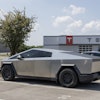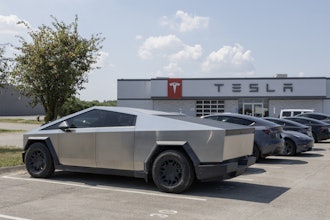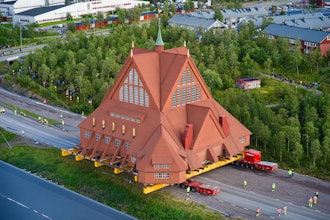
WASHINGTON (AP) — Nuclear industry hopes of one day bringing small, factory-built nuclear power plants to communities and industrial sites have cleared a first regulatory hurdle with the Trump administration, over objections from the Federal Emergency Management Agency and others that regulators are cutting corners on safety and disaster planning.
The Nuclear Regulatory Commission approved a preliminary site permit this week sought by the Tennessee Valley Authority, the nation's largest public utility, for a so-called small modular reactor near Oak Ridge, Tennessee. It’s the first such permit in the country. Moving ahead on any such project would require a string of other regulator sign-offs, putting installation and opening of one of the less-chunky nuclear plants years away at the earliest.
The country’s nuclear industry, struggling as cheaper natural gas and renewable energy outguns power from big, aging nuclear plants, says a new generation of smaller, modular reactors using the latest technology could serve as a carbon-free alternative for climate-damaging coal and natural gas plants, with less cash outlay up front for operators.
“If you’re serious about climate, you have to be serious about existing and new nuclear,” said Matthew Wald, a spokesman for the industry’s Nuclear Energy Institute trade group.
Opponents say regulators already are cutting corners for the small modular plants still under development, and moving toward allowing emerging nuclear technology, nuclear waste and risks from radiation and terrorism into communities not equipped to deal with the threats.
Edwin Lyman, a scientist and nuclear expert with the Union for Concerned Scientists non-profit, called this week's regulation-easing moves "deeply flawed and reckless.''
The nuclear industry argues that the proposed lower-megawatt, up-to-date reactors will be ”so safe and small you can put them anywhere," Lyman said. Cutting the safety rules accordingly — and dangerously so, Lyman says — makes "it easier to put one of those reactors in a city.''
The main item of controversy in this week's approval was the NRC’s agreement with the utility to consider waiving a mandate that nuclear plant operators have evacuation routes and other emergency response plans in place for a 10-mile zone around nuclear plants.
Regulators have now agreed that full-on emergency planning by plant operators could stop at a two-mile zone, or even at a nuclear power plant fence line, if it was deemed the radiation risks from a small modular reactor were reduced enough.
FEMA has objected. The federal disaster agency said in letters and comment to the NRC that any consideration of narrowing or eliminating the emergency zone for the small modular reactors had to take into account the possibility of inside attacks, cyber threats, a national-security emergency, and other threats, not just calculations of radiation releases.
Reduced emergency planning by plant operators would shift more of that burden to government, FEMA said.
NRC commissioner Jeff Baran also raised concerns, and objected to exempting nuclear plants of all but a boundary-line emergency planning zone. Any consideration of cutting protections for people who live and work around a reactor had to take into consideration the possibility of a quick succession of disasters hitting, as with the 2011 quake and tsunami that triggered Japan's Fukushima nuclear meltdowns, Baran wrote in a dissent.
Another NRC commissioner, Annie Caputo,' said the panel's decision was ''responsive to congressional direction and is protective of public health and safety in accordance with the inherent safety embodied in these designs.''
Lyman, with the Union for Concerned Scientists, warned the NRC could be setting a precedent for safety shortcuts as development moves ahead on small modular reactors and new nuclear power technology.
The NRC moves “will cause undue risk to public health and safety from both nuclear accidents and terrorist attacks,’’’ Lyman said in a statement.
Industry planning for small modular reactors generally calls for them to be installed mostly underground, “which makes security a little simpler,’’ Wald, the spokesman for the nuclear trade group, said.
The trade group called the NRC’s actions Tuesday “a major milestone.’’
With its steps, the NRC was showing its “commitment to modernizing regulations so they align with the smaller size and the inherent safety features of advanced nuclear technologies,’’ the Nuclear Energy Industry said in a statement.
The Trump administration has moved to ease regulatory requirements on businesses overall, including for the nuclear industry. President Donald Trump calls them unnecessarily burdensome.
Administration support includes encouraging research and development of the next generations of reactors and technology, including small modular reactors, as competition from natural gas, solar and wind power prods utilities to close more old-style nuclear plants.
The permit granted this week gives the TVA 20 years to consider building one or more small modular reactors, totaling no more than 800 megawatts, at the site near Oak Ridge. Small modular reactors are 300 megawatts or smaller, one-half or less the size of most conventional plants.
Any decision by TVA to go ahead would depend on energy demand and economic factors, Dan Stout, a nuclear technology director at the utility, said in a statement.
Separately, reactor developer NuScale is pursuing NRC design approval for a small modular reactor it wants to install at Idaho National Laboratory outside of Idaho Falls, in partnership with a Western group of city-owned power utilities and the Department of Energy.





















